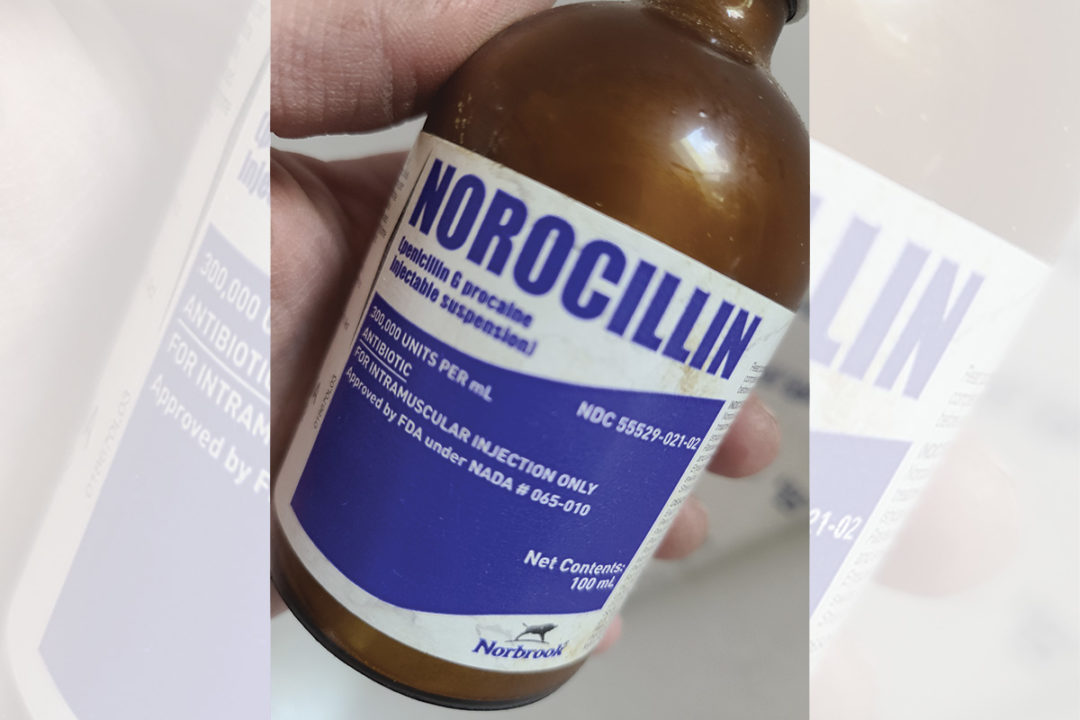“It hit the news and now everyone is worried about it, but I don’t think it will affect my clients that much,” says Helen Rowland, DVM, of Cottonwood Veterinary Service.
“It” is the upcoming shift in animal antimicrobial medicine access. As of June 11, antibiotics currently sold over the counter will have new labels that require them to be sold only with a prescription from a veterinarian. “Notable inclusions are oxytetracycline, penicillin and various sulfas,” says Idaho State Veterinarian Dr. Scott Leibsle. This change is the last step in a process that has been ongoing since 2012.
The Center for Veterinary Medicine’s Guidance for Industry (GFI) #263 is “driven by the concept that medically important antimicrobial drugs should only be used in animals when necessary for the treatment, control or prevention of specific diseases,” as the document says.
Impact on human medicine?
“The intent is to create responsible use of antibiotics also used in the human field,” says Leibsle. Leaning too heavily on any particular drug can eventually lead to resistance in target populations, and antimicrobial-resistant microbes are a cause for alarm in human medicine. In 2019, the Centers for Disease Control and Prevention (CDC) estimated that antibiotic resistance causes over 23,000 deaths in the U.S. annually.
The concern is that improper use of drugs (including those intended for both humans and animals) contributes to antimicrobial-resistant populations of microbes that can affect humans. Taking a partial course of antibiotics, for example, will initially kill the microbes most susceptible to the drug and perhaps allow the survival of those less susceptible. The end result is a population that is overall less susceptible to control by that drug.
Another misuse that can contribute to the development of antimicrobial-resistant populations is taking medicine when it isn’t needed, or when another medication would be more suited to the infection. There have even been examples of humans taking over-the-counter antibiotics intended for fish or other animals.
“There is a tendency to blame the livestock side of the world for the antibiotic resistance that’s been building up for years,” says Kelton Spain of Premier Livestock Consulting. While he says abuses no doubt exist in the industry, he sees them as a small component of a larger problem.
Current data does not show a link for antibiotic resistance to transfer from animals to humans, but scientists believe it is plausible. With the real specter of antibiotic-resistant drugs looming, that potential is enough for policymakers.
Impact on producers
Since the change affects labeling, affected drugs with old labels may still be purchased over the counter. That is, suppliers are allowed to deplete their current supply of medicines even after the June 11 deadline. But producers should be prepared for these stocks to sell out (or expire) and to see the new labels hitting the shelves soon.
“The most obvious implication is that producers who don’t have a regular relationship with a vet need to get one,” says Leibsle.
This relationship is required for a veterinarian to legally write a prescription. For a veterinarian-patient-client relationship, the veterinarian has to have seen the producer’s animals within the past 12 months.
For most producers – including Spain’s clients – this shouldn’t be a problem. “A lot of the producers with 50 cows or more are getting their cows preg checked and their bulls trich tested,” Spain says. “The people who it’s going to affect are the 4-H kids and folks with just a couple calves they bought at the sale.”
Rowland says it is unlikely to affect her practice much, if at all. “I already put labels on medicines and discuss proper use and withdrawal times with my clients when I dispense meds,” she says. And unlike in humans, the prescription need not be written on a case-by-case basis. “I can write a script for a producer to have a medicine on hand ahead of time, as long as I know what it’s for and have worked on their animals before. It will be like Draxxin and Resflor are now – these medicines will be available to use as prescribed.”
Even those producers who prefer to purchase from retail outlets or other sources may not see too much of a disruption if they have a veterinarian-patient-client relationship. “You may still be able to get your medicines at the same place,” says Leibsle. “It will just require a prescription.”
For those without that relationship already in place, it may be a challenge to find a veterinarian who is accepting new clients. “We’re short of vets all over the country,” says Spain. But, just as producers adjusted to the changes leading up to this one, no doubt they will take this one in stride, too. “It’s just one of those things we’ll have to deal with,” he says.

.jpg?t=1687979285&width=640)


.jpg?height=auto&t=1713304395&width=285)


